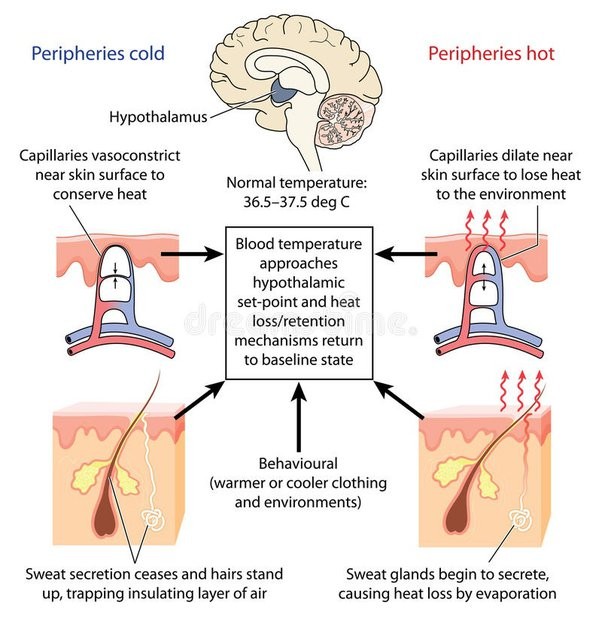
Contents
Where Do We Lose Most of Our Heat?
Four channels by which body heat is lost include the lungs, skin, eating or drinking, and waste elimination.
Understanding how your body gains and loses heat is critical to staying warm, especially in harsh conditions like camping.
The body must maintain a steady temperature for proper organ function. When exposed to cool temperatures, heat loss can be harmful if not managed.
Our bodies lose heat in various ways.
Four channels through which heat is lost from the body:
- Lungs:
- Heat loss occurs when warm air is blown out, felt when softly blowing on the back of your hand with your mouth open.
- Heat loss is caused by water vaporization from the lungs.
- Skin:
- Nearly 85 percent of heat loss happens through the skin via conduction, convection, radiation, and sweat evaporation.
- Foods:
- Heat is lost when consuming cold foods or liquids.
- Feces and urine:
- Considerable heat can be released during waste elimination.
What is Body Heat?
Body heat is thermal energy produced as a by-product of metabolism in mammals, which regulate their body temperature despite environmental fluctuations.
- Mammals retain body heat by erecting hair and restricting blood flow to the skin and extremities.
- They can increase body temperature through shivering and exercise.
Body heat is primarily expelled by increasing blood flow to the surface and extremities, sweating, panting, and maximizing body surface exposure.
3 Mechanisms for Heat Escape
Three mechanisms allow heat to escape from high to low temperature, either individually or in combination:
- Conduction:
- Heat is transported through particle collisions from a hot area to a cool one.
- Energy is stored in the vibration of atoms in solids, where atoms or molecules can transmit energy to nearby ones through contact or collision.
- Convection:
- Heat is transferred between fluid components (liquid or gas) through bulk movement of the fluid itself.
- Hot parts of a fluid or gas ascend due to their lower density compared to colder parts, with warmer fluids rising and being replaced by cooler ones from above.
- Radiation:
- Heat is transported through space by electromagnetic waves.
- In contrast to conduction and convection, radiation does not require a medium (molecules or atoms) and can transfer energy even in a vacuum.
In conclusion, convection displaces heated air surrounding the body with colder air, while conduction involves heat loss through contact with cooler objects. Radiation is the primary method by which body heat decreases as it is lost to the air through heatwaves.
How Do We Regulate Heat?
The body regulates heat production and loss to maintain optimal performance.
- The hypothalamus, a small region of the brain, acts as the command center for bodily activities, including temperature regulation.
- Similar to a thermostat, the hypothalamus responds to internal and external inputs, adjusting to keep the body within one or two degrees of 98.6°F.
Hormones
- The hypothalamus fine-tunes temperature-control actions, balancing body fluids, maintaining salt concentrations, and regulating the release of temperature-related compounds and hormones.
- It collaborates with other components like the skin, sweat glands, and blood vessels, which work as the body’s vents, condensers, and heat ducts.
- The dermis, the middle layer of skin, holds most of the body’s water.
- When heat stimulates sweat glands, water and salt from sweat are transported to the skin’s surface, where it evaporates, cooling the body.
Blood Flow
- Blood vessels expand and contract based on internal hormones and chemical changes, transferring heat closer to or away from the skin to release or conserve heat.
- When all aspects of the body’s heat-regulating mechanism work properly, body temperature remains near 98.6°F.
How Can I Stay Warm During Camping or Hiking?
In the great outdoors, body heat becomes a greater issue. There are fewer sheltered spots to seek refuge, and household appliances aren’t available to provide warmth.
Here are some tips for staying warm during camping or hiking trips.
Proper Camping Equipment
- Invest in proper camping equipment and an excellent sleeping bag made of insulating materials that trap air and keep it from escaping your body, maintaining a comfortable temperature.
- A well-insulated tent prevents hot air from escaping or cold air from entering.
While a good tent and sleeping bag protect against heat loss, you can take additional steps to reduce the risk.
- Clothing:
- Dress appropriately with multiple layers and thermal clothing to retain body heat.
- Wear several pairs of socks and waterproof shoes to keep feet warm.
Knowing how to preserve body heat is vital for a happy, healthy, and comfortable camping or hiking experience.


